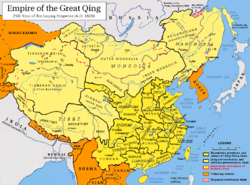
Back Tannu Uriankhai AST Tandı Uranhay Azerbaijani تاندی اۇرانهای AZB Тану-Ўранхай BE-X-OLD Tannu Urianjái Spanish Tannu Uriankhai French Tannu Uriankhai ID タンヌ・ウリャンハイ Japanese 탕누 우량하이 Korean Тагнын Урианхайн хязгаар Mongolian
Tannu Uriankhai | |||||||||||
|---|---|---|---|---|---|---|---|---|---|---|---|
| 1757–1911 | |||||||||||
|
Flag (1889–1912) | |||||||||||
 Tannu Uriankhai within Qing China | |||||||||||
| Status | Unorganized autonomous region of the Qing dynasty | ||||||||||
| Common languages | Tuvan, Mongolian, Chinese, Russian | ||||||||||
| Religion | Tibetan Buddhism, Shamanism | ||||||||||
| Government | Feudal state | ||||||||||
| Amban Noyan | |||||||||||
• 1762–1769 (first) | Manadzhab | ||||||||||
• 1899–1911 (last) | Oyun Ölzey-Ochur oglu Kombu-Dorzhu | ||||||||||
| History | |||||||||||
• Established | 1757 | ||||||||||
• Disestablished | December 1911 | ||||||||||
| |||||||||||
| Today part of | Russia Mongolia | ||||||||||
Tannu Uriankhai (Tuvan: Таңды Урянхай, [taŋˈdɤ urʲanˈχaj]; Mongolian: Тагна Урианхай, romanized: Tagna Urianhai, [ˈtʰaɢəɴ ʊrʲæŋˈχæɪ̯];[1] simplified Chinese: 唐努乌梁海; traditional Chinese: 唐努烏梁海; pinyin: Tángnǔ Wūliánghǎi) was a historical region of the Mongol Empire, its principal successor, the Yuan dynasty, and later the Qing dynasty. The territory of Tannu Uriankhai largely corresponds to the modern-day Tuva Republic of the Russian Federation, neighboring areas in Russia, and a small part of the modern state of Mongolia.
Tannu designates the Tannu-ola Mountains in the region, and Uriankhai was the Mongolian name for the Tuvans (and accordingly their realm), which meant "the people living in the woods" (Chinese: 林中百姓; pinyin: Línzhōng Bǎixìng).
After Mongolia (Outer Mongolia) declared independence from the Qing dynasty and the Republic of China in the early 20th century, the region of Tannu Uriankhai increasingly came under Russian influence and finally became an independent communist state, the Tuvan People's Republic, which was annexed by the Soviet Union in 1944.
Sovereignty over the area has not been officially renounced by the Republic of China since 1949.
Referring to the 2001 Sino-Russian Treaty of Friendship, the People's Republic of China (PRC), which controls Mainland China, has not officially renounced its sovereignty over the area, but just "have no remaining territorial claims" for two countries.[2] However, the PRC has official contacts with Tuva and regards it as part of Russia.[3][4]
- ^ Ц.Цэрэндорж. "Тагна Урианхай". Монголын түүх.
- ^ "The Unlikely Prospect of Long-Term Sino-Russian Cooperation: Points of Divergence in the Emerging Security Environment". Over the Horizon (OTH). 2019.
Article 6 of the 2001 Sino-Russian Treaty of Friendship states that the People's Republic of China and the Russian Federation have no remaining territorial claims.
- ^ "中华人民共和国版图". 中国政府网. 2017. Archived from the original on 2020-01-28.
- ^ "外交部部长助理李惠来会见俄罗斯图瓦共和国行政长官绍尔班". 中国外交部. 2021-05-02. Archived from the original on 2021-05-07.
© MMXXIII Rich X Search. We shall prevail. All rights reserved. Rich X Search
